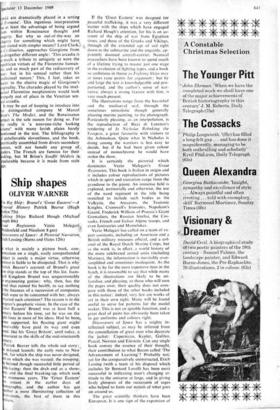Ship shapes
OLIVER WARNER
he Big Ship: Brunel's 'Great Eastern'—A ciorial History Patrick Beaver (Hugh velyn 75s) fighting Ships Richard Hough (Michael° oseph 84s) reat Regiments Vezio Melega Veidenfeld and Nicolson 8 gns) scoverers of Space: A Pictorial Narrationt rich Lessing (Burns and Oates 120s) what is mainly a picture book, con-, ntration on a single, easily comprehended bject is surely a major virtue, otherwise, crest is liable to be dissipated. That is why. arick Beaver's account of Brunel's great on ship stands at the top of this list. Isam- rd Kingdom Brunel was unquestionably engineering genius: why, then, has the ssel that ruined his health, to say nothing the finances of a succession of companies hich were to be concerned with her, always iracted such attention? The reason is in the signer's prophetic vision. In the case of the reat Eastern' Brunel was at least half a ntury before his time, yet he was on the ght lines in most of his ideas. Had he been., tter supported, his floating giant might nceivably have paid its way and even Sled, like his `Great Britain', until today, a onument to the skills of the mid-nineteenth ntury.
Patrick Beaver tells the whole sad story:4, e delayed launch; the early runs to New ork, for which the ship was never designed, d on which she was wasted; the trooping; belated though successful little period of ble-laying; then the drab end as a show-, and the final breaking-up, which took 0 strenuous years. The 'Great Eastern' extant in the earlier days of 0tography, and the author has got ther a most illuminating collection of strations, the best of them in this 'Urn,
If the `Great Eastern' was designed for peaceful trafficking, it was a very different matter with the ships which have engaged Richard Hough's attention, for his is an ac- count of the ship of war from Egyptian times, and those of the Greeks and Vikings, through all the extended age of sail right down to the submarine and the ungainly, ap- parently doomed aircraft-carrier. Nautical researchers have been known to spend much of a lifetime trying to master just one stage in the evolution of fighting types, and a book so ambitious in theme as Fighting Ships may at times raise points for argument: but by and large the text is knowledgeable and pro- portioned, and the author's sense of nar- rative, always a strong feature with him, is very much present.
The illustrations range from the bas-relief and the mediaeval seal, through the sometimes unrealistic though generally pleasing marine painting, to the photograph. Particularly pleasing, as an interpolation, is fhe reproduction of Bicci di Lorenzo's rendering of St Nicholas Rebuking the Tempest, a great favourite with visitors to the Ashmolean. Quite what St Nicholas is doing among the warriors is less easy to decide, but if he had been given colour instead of monochrome he would have stolen the show.
It is certainly the pictorial which dominates Vezio Melegari's Great Regiments. This book is Italian in origin and it includes colour reproductions of pictures which in spirit and execution range from the grandiose to the jejune. An immense field is explored, territorially and otherwise, the use of the word regiment in the title being stretched to include such bodies as the Valkyrie, the Amazons, the Teutonic Knights, Cromwell's Ironsides, Napoleon's Guard, Frederick William of Prussia's Giant Grenadiers, the Russian Streltsi, the Cos- sacks, French and Italian Alpine troops, and even Janissaries and Mamelukes.
Vezio Melegari has called on a team of ex- pert assistants, including an American and a British military museum official, and a col- onel of the Royal Dutch Marine Corps, but as the work is, in effect, a world history of the more celebrated armed units (including Marines), the information is inevitably over- simplified and sometimes inadequate. As the book is by far the most expensive item in the batch, it is reasonable to say that while many of the illustrations are likely to be un- familiar, and pleasing, to those who will turn the pages over, their quality does not com- pare with those of the other books included in this notice: indeed, very few are works of
art in their own right. Many will be found useful to serve for patterns for the model
maker. This is not an ignoble function, and a great deal of pains has obviously been taken to get uniforms and colours right.
Discoverers of Space has a mighty in- tellectual subject, as may be inferred from the constellation of great men who decorate the jacket: Copernicus, Kepler, Galileo, Pascal, Newton and Einstein. Can any single book convey the essence of their thought, their contribution to what Bacon called 'The Advancement of Learning'? Probably not; yet for the comparatively uninstructed, Erich Lessing (with a team at his disposal which. includes Sir Bernard Lovell) has been most successful in indicating man's changing at- titude to the universe at large, and-in giving lively glimpses of the succession of sages who helped to form our notion of what goes on around us.
The great scientific thinkers have been European. It is one sign of the expansion of communication that the principal immediate heirs to centuries of arduous thought in the realm of physics should be American. America is wonderfully generous in sharing knowledge of her technical achievements. The world still awaits any sustained gesture of the same sort on the part of Russia.















































 Previous page
Previous page